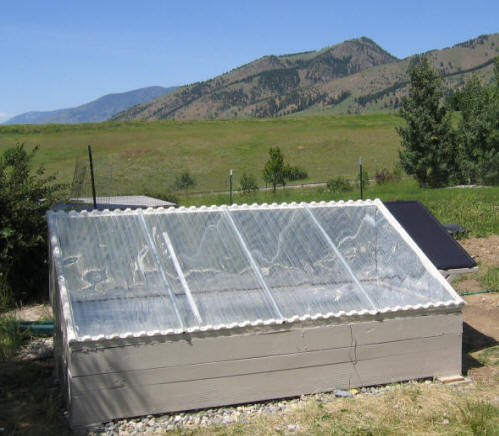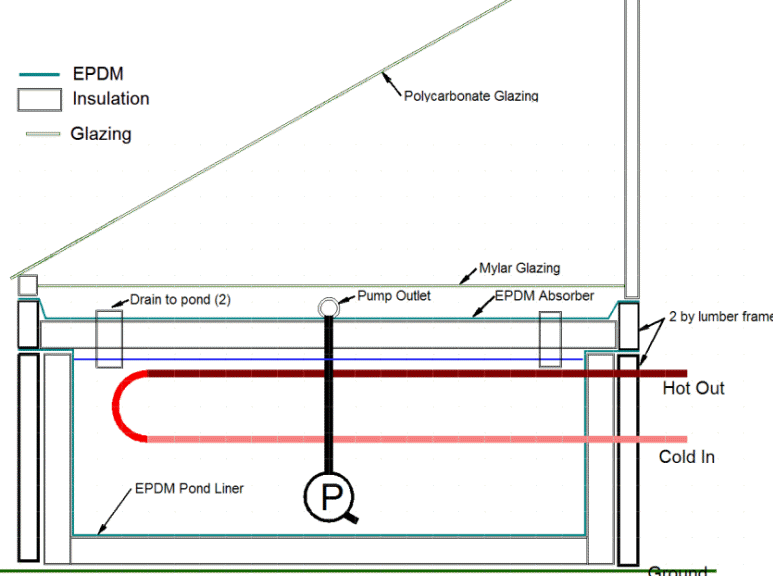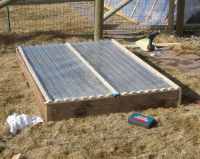
Search
The Renewable Energy site for Do-It-Yourselfers
Solar Pond Domestic Hot Water Heater
-- Prototype 3
|
This is an update on the simple solar
water heating system that Nick Pine and I have been working on.
This is the third prototype. It
is showing some promise, but still has at least one unresolved problem with high
nighttime losses (see performance section). Any ideas for resolving the
performance problem, or improving the design would be most welcome.
Directory:
|
|

Goals
The Goals for this project are:
-
An efficient solar heater with
performance comparable to commercial units.
-
A long life with little
maintenance.
-
Four season operation in cold
climates *
-
Easy to build -- a weekend project
(well, maybe a long weekend)
-
Low cost -- less than $500 with all
new, high quality materials (much less if you have a good scrap pile, or
scrounge well)
-
Use only readily available
materials.
* This does not mean that it produces
100% of your hot water in the winter -- it would take a much larger
collector to do this. Nick would argue that the collector should be
made large so that it does meet nearly all your year round water needs, and that
is certainly possible.
Overview of the Heater
This solar water heater consists of:
-
An insulated pond that stores solar
heat (about 4ft by 8 ft and 11 inches deep on the prototype)
-
A pipe coil immersed in the pond
that your water flow through on its way to your heater. The water in the
pipe coil is preheated by the pond water.
-
A combination absorber and
insulating lid that absorbs solar energy. The insulated lid also reduces
heat loss from the pond.
-
A small solar electric pump that
pumps water from the bottom of the pond to the top of the absorber, where it
picks up heat and then drains back into the pond.
-
A glazed cover that is high on the
north side, and slopes down to the pond level on the south side. The
north, east, and west walls of the cover are reflectors to direct additional
sun onto the absorber.

Schematic cross section of the solar
pond water heater.
The pond is well insulated, and lined
with an EPDM membrane for a long, leak free life. The prototype is
sized to meet a good fraction of the hot water demand for two people -- it can
be made larger to satisfy larger demands.
In operation, when the PV panel is
exposed to sun, it starts the pump up. The pump pumps water from the
bottom of the pond up onto the EPDM absorber. The water forms a shallow
pool on top of the EPDM that is about a half inch deep. The water heats up
as it flows around on top the absorber, and eventually this heated water finds
the drain that drains it back down into the pond.
When there is no sun, the PV panel
does not generate enough power to run the pump, and it stops. The water in
the pool on top the EPDM drains back into the pond. This leaves you with a
pond storing hot water that is well insulated, and has low heat loss.
When the house calls for hot water,
the initial water comes from the water that is already in the pipe coil, and is
up to the same temperature as the tank water. The coil itself holds enough
water that just the water in the coil will satisfy most single hot water
demands. For the prototype, the 200 ft of 1 inch diameter poly pipe
holds about 8 gallons. The coil can be made longer or larger in diameter
to hold more water if desired -- a 300 ft coil of 1 inch poly pipe might be a
good choice at 12 gallons. If more hot water is needed than can be
supplied by the water in the pipe coil itself, then the water is still heated as
it flows through the pipe coil, and the water coming out of the pipe coil
outlet will be preheated, but not up to the full pond temperature.
The pipe coil is acting as a heat exchanger to pick up heat from the pond.
The draw tests shows how this works for the prototype.
The final design will have a thermal
switch that will shut the pump off when the pond temperature reaches 140F.
This is to protect the black poly pipe pipe and the EPDM liner. This can be done with
a simple $10 thermal snap switch.
Potential Problems/Challenges
This is still and experimental
concept. Here are some known potential problems -- there may be other ones
unknown ones as well -- as always.
-
The High Density Polyethylene pipe
may not stand up to a combination of high pressure and high temperature.
It will definitely be at the limit of its intended use.
This is why the tank temperature must be limited to 140F (or so) with the
thermal switch.
I used the lowest pressure NSF approved PE pipe I could find (100 psi)
just to get an idea if this is a problem or not. Using higher pressure
PE pipe (160, or 200 psi) would provide more margin.
PEX or PEX-AL-PEX might provide somewhat more temperature capability than the
HDPE pipe, and would be a good candidate to try.
If all else fails, a shorter, smaller diameter coil of copper pipe could be
used -- copper is such a good conductor that the pipe coil would not have to
store a substantial amount of water.
-
The life of the EPDM absorber may
not be up to expectations, although it has been used successfully in this type
of application before. The EPDM pond lining should have a very good
life.
-
The small pump used in the
prototype will almost certainly not have a long life. One of the
remaining challenges is finding a small 12 VDC pump that pumps about 2 gpm and
will have a long life at 140F, and does not cost an arm and a leg.
-
One caution is that the pond is
filled with water that is hot enough to scald. The water is protected by
the glazing layer, and by the absorber/lid, but this is still a hazard worth
considering. If this is a concern, then using something like twinwall
polycarbonate glazing with good glazing supports might be one solution.
Construction
The construction is intended to be
simple, use readily available materials, and require no special tools.
The construction of the water heater
is covered here in detail.
Performance and Tests
The performance testing is
covered
here.
There is currently an unresolved
problem with high losses during the night (see the Day/Night test under link
above).
Any comments on this would be
welcome.
Comparing to Other Solar Water
Heaters
We may be a bit biased on this, since
we came up with this design in an effort to answer some of the short comings we
saw in existing solar water heaters, but here is how we see the tradeoffs.
Batch Water Heater:
Batch solar water heaters are a nice
simple design that can provide a high fraction of your hot water in warm
climates. They can also be used in cold climates, but must be drained for
the winter. Another shortcoming of this design is that the tank
temperature can drop quite a bit at night, because of the relatively high heat
loss out the glazing. There are some schemes that provide for night time
tank insulation, but these generally require that someone deploy the insulation
at night and remove it in the morning.
It can also be difficult to find a
good tank for the batch heater. If you can't find a used one in good
shape, then you pretty well have to buy a new water heater and strip off the
insulation and fittings to make a batch tank.
Our proposed design eliminates these
short comings at the cost of a bit more complexity, and few (not many) more
dollars.
Commercial Drainback and Closed Loop
Systems:
These systems work fine, have
relatively low maintenance, and a long life. But, they are expensive --
several thousand dollars. People into building things can
tackle one of these systems, but it is a fairly involved task, and the
components are expensive.
The goal of the new design is to
provide equivalent performance and life to these commercial systems at a much
lower cost.
Work on the earlier prototypes of the
solar pond water heater can be found here:
Gary 6/25/07



 An
experimental concept for solar heating water that uses a pipe coil in a
glazed pond to collect energy.
An
experimental concept for solar heating water that uses a pipe coil in a
glazed pond to collect energy.